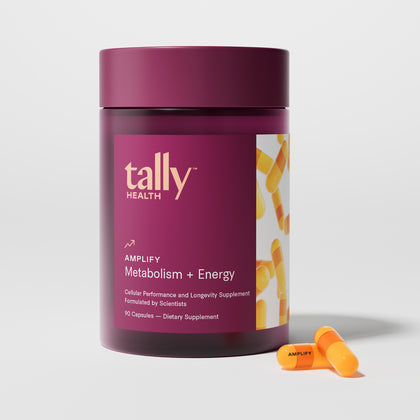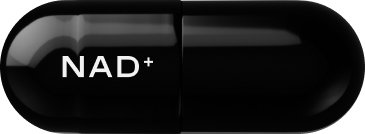

When it comes to energy, aging, and overall health, mitochondria are at the center of it all. These tiny organelles—often called the "powerhouses of the cell"—generate the ATP (adenosine triphosphate) that fuels nearly every biological process in the human body.
But as we age, mitochondrial function declines. That’s not just a minor inconvenience—it’s one of the key hallmarks of aging and a contributor to many age-related and chronic diseases. This is where mitochondrial supplements come in. These are nutrients and bioactives designed to support mitochondrial health, improve cellular energy production, and potentially slow biological aging.
Let’s break down the science behind mitochondrial supplements, the most well-researched ingredients, and how they fit into a pro-longevity routine.

Why Mitochondrial Function Matters for Health and Aging
Mitochondria don’t just produce energy—they also regulate metabolism, cell signaling, immune function, and even apoptosis (programmed cell death). When they stop functioning properly, it can set off a cascade of cellular dysfunction. Mitochondrial decline has been linked to conditions such as neurodegeneration, metabolic syndrome, cardiovascular disease, and sarcopenia (muscle wasting).

1. Neurodegeneration and Cognitive Decline
The brain is one of the most energy-demanding organs in the body, consuming up to 20% of total oxygen and energy despite accounting for only 2% of body weight. Neurons are heavily reliant on mitochondrial ATP production for neurotransmission, synaptic plasticity, and neurogenesis.
As mitochondrial efficiency declines with age, neurons become more vulnerable to oxidative stress and energy shortages, contributing to neurodegenerative diseases like Alzheimer's and Parkinson’s. Damaged mitochondria can also release pro-inflammatory signals and trigger neuronal death, further accelerating cognitive decline.
2. Metabolic Dysfunction and Insulin Resistance
Mitochondria are critical for glucose and lipid metabolism. They oxidize fatty acids and pyruvate to fuel the production of ATP. In aging and metabolic diseases like type 2 diabetes, mitochondria lose this efficiency.
Mitochondrial dysfunction has been linked to insulin resistance, reduced fatty acid oxidation, and increased lipid accumulation in tissues like liver and muscle. Supporting mitochondrial health is increasingly seen as a strategy for maintaining metabolic flexibility and preventing metabolic syndrome.
3. Muscle Weakness and Sarcopenia
Skeletal muscle is packed with mitochondria due to its high energy demand. As we age, mitochondrial density and function in muscle tissues decline, contributing to sarcopenia—the age-related loss of muscle mass and strength.
This decline in mitochondrial capacity leads to reduced endurance, slower recovery, and increased fatigue. Interventions that stimulate mitochondrial biogenesis and improve function have been shown to improve muscle performance and may slow physical aging.
4. Immune System Dysfunction and Inflammaging
Mitochondria play a central role in immune cell signaling, especially in the activation of innate immunity. Dysfunctional mitochondria can release mitochondrial DNA (mtDNA) and other danger signals that contribute to chronic inflammation—a phenomenon known as “inflammaging”.
This chronic, low-grade inflammation is linked to many age-related diseases including cardiovascular disease, cancer, and frailty. Enhancing mitochondrial quality control mechanisms, such as mitophagy, may reduce these inflammatory signals and support healthy immune function.
5. Cellular Senescence and Energy Collapse
Aging cells often enter a state of senescence, where they no longer divide but remain metabolically active and secrete inflammatory factors. One trigger for cellular senescence is mitochondrial dysfunction and loss of ATP production.
Senescent cells are energy-starved and contribute to tissue dysfunction and aging throughout the body. Maintaining mitochondrial energy output is essential for delaying senescence and preserving tissue regeneration over time.
What Is a Mitochondrial Supplement?

A mitochondrial supplement is a type of nutritional supplement designed to support healthy mitochondrial function. These dietary supplements typically include nutrients that are designed to:
Support mitochondrial biogenesis (creation of new mitochondria),
Enhance electron transport chain efficiency,
Boost levels of molecules involved in cellular energy production (e.g., NAD + and CoQ10), or
Reduce oxidative damage to mitochondrial membranes and DNA.
These nutritional supplements aren’t magic pills—but they’re part of an emerging toolkit to support mitochondrial resilience, especially as we age. As with any dietary supplement, it is important to consider quality, safety, and scientific evidence before adding a mitochondrial supplement to your daily routine.
The Most Well-Studied Dietary Supplements for Mitochondrial Health

Here are some of the most promising ingredients backed by clinical and preclinical evidence that have been used to support mitochondrial function. Many mitochondrial support supplements often combine several of these ingredients to maximize benefits.
1. NAD+ Precursors
NAD + (nicotinamide adenine dinucleotide) is essential for mitochondrial energy production. It helps shuttle electrons through the electron transport chain and activates sirtuins—enzymes involved in mitochondrial repair and epigenetic maintenance.
Unfortunately, NAD+ levels decline significantly with age, contributing to mitochondrial dysfunction and age-related decline. Supplementing with NAD+ precursors like niacinamide, nicotinamide riboside (NR), or nicotinamide mononucleotide (NMN) has been shown to restore NAD+ levels and improve mitochondrial function.
➡️ Tally Health’s NAD+ supplement supports mitochondrial energy by helping replenish intracellular NAD+ levels, thereby supporting cellular vitality and healthy aging.
2. Coenzyme Q10 (CoQ10)
CoQ10 is a cofactor in the mitochondrial electron transport chain and acts as a potent antioxidant. Levels decline with age, and supplementation can improve mitochondrial energy output and reduce oxidative damage. CoQ10 is a key ingredient in Amplify by Tally Health.
3. Alpha-Lipoic Acid (ALA)
ALA is both water- and fat-soluble, allowing it to protect various parts of the cell, including mitochondria. It supports mitochondrial enzyme function and regenerates other antioxidants like glutathione.
4. PQQ (Pyrroloquinoline Quinone)
PQQ may stimulate mitochondrial biogenesis through activation of the PGC-1α pathway—a master regulator of mitochondrial growth.
5. L-Carnitine & Acetyl-L-Carnitine
These amino acid derivatives help shuttle long-chain fatty acids into mitochondria for energy production. Acetyl-L-carnitine, in particular, has been shown to improve mitochondrial function in aging brains.
What the Research Says

In recent years, the study of mitochondrial-targeted supplements has expanded rapidly. Multiple clinical trials have now demonstrated improvements in biomarkers of mitochondrial function, endurance, and fatigue in older adults taking NAD+ precursors, CoQ10, and/or carnitine.
Moreover, mitochondrial health is tightly intertwined with biological aging. Improving mitochondrial efficiency can support longevity pathways, from enhanced DNA repair to reduced systemic inflammation.
Should You Take a Supplement for Mitochondrial Support?
If you’re interested in improving your energy, cognitive performance, or long-term health, a mitochondrial supplement may be worth considering—especially one that includes ingredients shown to replenish NAD + , protect mitochondrial membranes, and promote mitochondrial biogenesis.
Of course, no supplement replaces the basics: sleep, exercise, nutrient-dense food, and stress management all support mitochondrial function and mitochondrial health.
But for those looking to go a step further, NAD+ and Amplify by Tally Health are scientifically formulated supplements designed to support mitochondrial health and mitochondrial energy metabolism at the cellular level.
Mitochondrial Disorders: When Energy Systems Fail
While most discussions of mitochondrial health focus on aging, it's important to note that mitochondria can also be directly impaired by inherited mitochondrial dysfunction and diseases. These are a group of rare but serious disorders caused by mutations in either mitochondrial DNA (mtDNA) or nuclear genes that regulate mitochondrial function.
Mitochondrial diseases can affect virtually any organ system, but are especially damaging to tissues with high energy demands—like the brain, heart, muscles, and liver. Symptoms may include muscle weakness, fatigue, seizures, developmental delays, hearing loss, and organ failure.
Although these disorders are rare, they highlight the essential role mitochondria play in human health. Research into treatments for mitochondrial disease has also advanced our understanding of how to support mitochondrial function more broadly—through lifestyle, pharmacological agents, and emerging mitochondrial supplements.
Final Thoughts

Mitochondria may be microscopic, but their impact on your health is anything but small. As science continues to uncover the mechanisms of aging, supporting mitochondrial health with targeted supplementation is becoming a promising strategy for enhancing energy, performance, and longevity.
What is a mitochondrial supplement?
A mitochondrial supplement is a type of nutritional supplement designed to support healthy mitochondrial function by promoting mitochondrial biogenesis, enhancing electron transport chain efficiency, boosting molecules involved in energy production (like NAD+ and CoQ10), and reducing oxidative damage to mitochondrial membranes and DNA.
Why does mitochondrial function matter for health and aging?
Mitochondria produce energy, regulate metabolism, control immune function, and manage cell death. When they stop functioning properly, it can lead to neurodegeneration, metabolic syndrome, cardiovascular disease, sarcopenia, and other age-related diseases.
What are some of the most well-studied supplements for mitochondrial health?
Some of the most researched ingredients include NAD+ precursors (such as Niacinamide), Coenzyme Q10, alpha-lipoic acid, PQQ, and L-carnitine/acetyl-L-carnitine.
Recommended Supplements
Citations
López‑Otín, C., Blasco, M. A., Partridge, L., Serrano, M., & Kroemer, G. (2013). The hallmarks of aging. Cell, 153(6), 1194–1217. https://doi.org/10.1016/j.cell.2013.05.039
Nunnari, J., & Suomalainen, A. (2012). Mitochondria: In sickness and in health. Cell, 148(6), 1145–1159. https://doi.org/10.1016/j.cell.2012.02.035
Chistiakov, D. A., et al. (2014). Mitochondrial Aging and Age-Related Dysfunction of Mitochondria. Biomed Research International, 2014, 238463. https://doi.org/10.1155/2014/238463
Sun, N., et al. (2016). The mitochondrial basis of aging. Molecular Cell, 61(5), 654–666. https://doi.org/10.1016/j.molcel.2016.01.028
Verdin, E. (2015). NAD+ in aging, metabolism, and neurodegeneration. Science, 350(6265), 1208–1213. https://doi.org/10.1126/science.aac4854
Yoshino, J., et al. (2018). NAD+ intermediates: The biology and therapeutic potential of NMN and NR. Cell Metabolism, 27(3), 513–528. https://doi.org/10.1016/j.cmet.2017.11.002
Trammell, S. A., et al. (2016). Nicotinamide riboside opposes type 2 diabetes and neuropathy in mice. Scientific Reports, 6, 26933. https://doi.org/10.1038/srep26933
Littarru, G. P., & Tiano, L. (2007). Bioenergetic and antioxidant properties of coenzyme Q10: Recent developments. Molecular Biotechnology, 37(1), 31–37. https://doi.org/10.1007/s12033-007-0052-y
Packer, L., et al. (1995). Alpha-lipoic acid as a biological antioxidant. Free Radical Biology and Medicine, 19(2), 227–250. https://doi.org/10.1016/0891-5849(95)00017-r
Chowanadisai, W., et al. (2010). Pyrroloquinoline quinone stimulates mitochondrial biogenesis. FASEB Journal, 24(6), 2190–2199. https://doi.org/10.1074/jbc.M109.030130
Elhassan, Y. S., et al. (2019). Nicotinamide riboside augments the aged human skeletal muscle NAD+ metabolome and induces transcriptomic and anti-inflammatory signatures. Cell Reports, 28(7), 1717–1728. https://doi.org/10.1016/j.celrep.2019.07.043
Gorman, G. S., Chinnery, P. F., DiMauro, S., Hirano, M., Koga, Y., McFarland, R., ... & Turnbull, D. M. (2016). Mitochondrial diseases. Nature Reviews Disease Primers, 2, 16080. https://doi.org/10.1038/nrdp.2016.80











